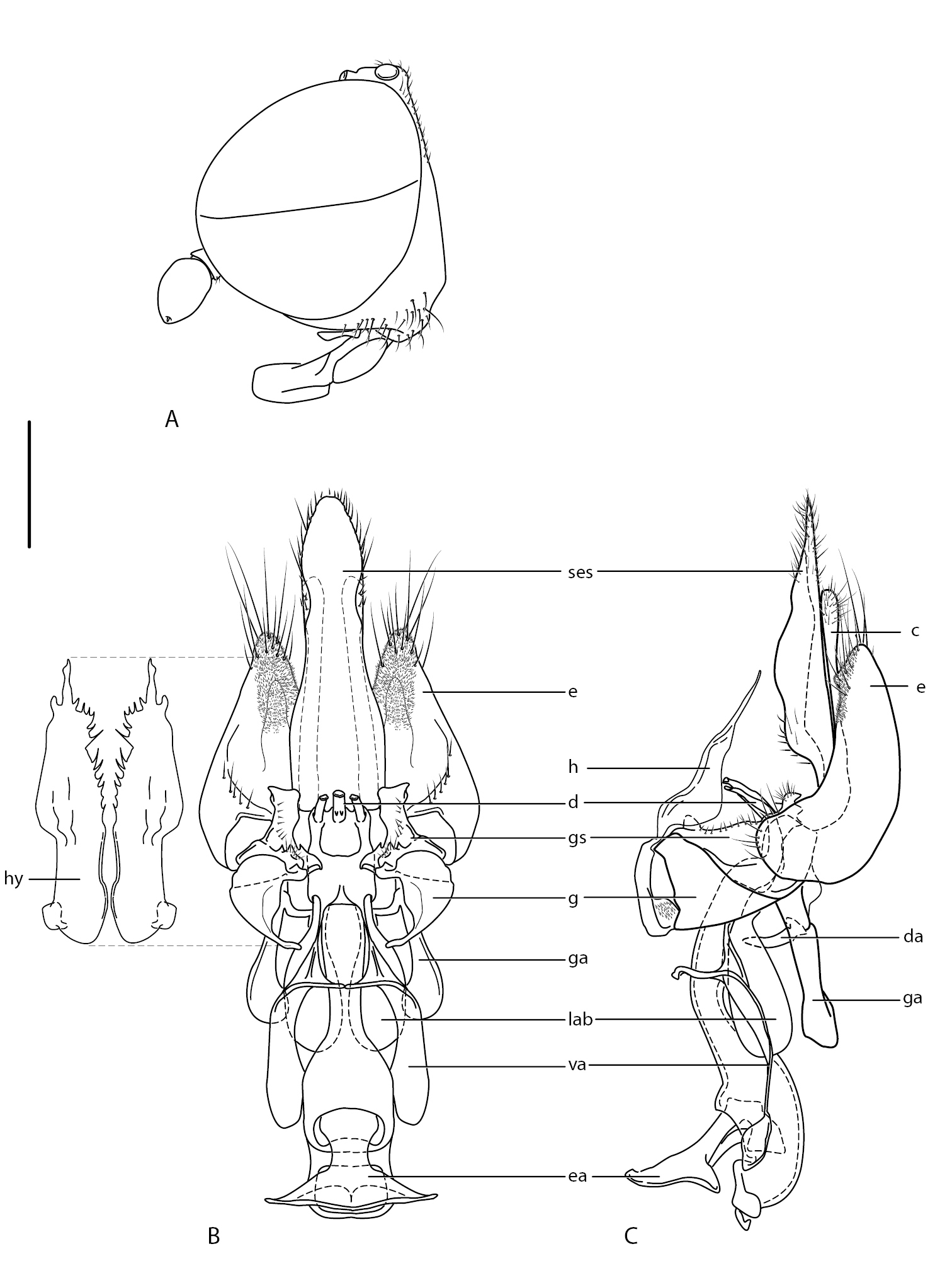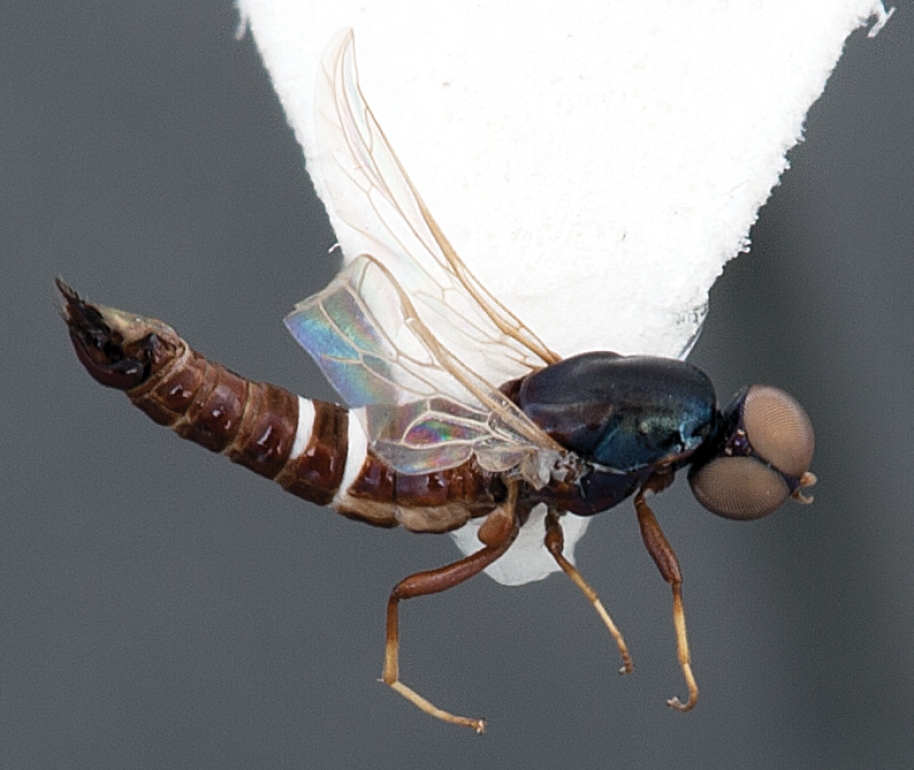(C) 2011 Shaun L. Winterton. This is an open access article distributed under the terms of the Creative Commons Attribution License, which permits unrestricted use, distribution, and reproduction in any medium, provided the original author and source are credited.
For reference, use of the paginated PDF or printed version of this article is recommended.
A new species of Prepseudatrichia Kelsey, 1969 (Prepseudatrichia tiger sp. n.) is described from Thailand, the first record of the genus from the Oriental region. A key to world species of Prepseudatrichia is given.
Therevoid clade, Asiloidea, Scenopinidae
Window flies (Diptera: Scenopinidae) are a small family (ca. 420 species in 24 extant genera) of cosmopolitan asiloid flies with an adult body size rarely exceeding 5.0 mm. Scenopinids are distributed throughout all major biogeographical regions, but with significant continental endemism at the genus level, and most genera confined to one or two biogeographical regions (Kelsey, 1973).
The genus Prepseudatrichia Kelsey, 1969 contains four described species from Africa (Prepseudatrichia mateui Kelsey, 1969, Prepseudatrichia stenogaster (Séguy, 1931) and Prepseudatrichia violacea Kelsey, 1969) and central Asia (Turkmenistan) (Prepseudatrichia kelseyi
Krivosheina, 1980). These rare flies are notable for their elongate,
glossy black body habitus, similar to members of the genera Pseudatricha Osten Sacken, 1877 and Neopseudatrichia
Kelsey, 1969. The elongate body shape and lack of pile in adults of
these genera is presumed to be a morphological adaptation for escaping
the narrow confines of wood boring beetle galleries, where species in
these genera appear as specialist predators of wood boring beetle
larvae. The larval and pupal stages of Prepseudatrichia kelseyi were described by
A distinctive new species of Prepseudatrichia (Prepseudatrichia tiger sp. n.) is described herein from Thailand based on a single male specimen. This is a new geographical record for this genus, previously known only from the Afrotropical and Palaearctic regions. A key to species of Prepseudatrichia is presented.
Materials and methodsGenitalia were macerated in 10% KOH at room temperature
for one day to remove soft tissue, then rinsed in distilled water and
dilute acetic acid, and dissected in 80% ethanol. Preparations were
then placed into glycerine, with images made with the aid of a digital
camera mounted on a stereomicroscope. Genitalia preparations were placed
in glycerine in a genitalia vial mounted on the pin beneath the
specimen. Terminology follows
(modified after
| 1 | Male | 2 |
| – | Female | 4 |
| 2 | Abdominal segments 3 and 4 with white bands; hypandrial lobes extended posteriorly as narrow triangular processes | 3 |
| – | Abdomen without white bands; hypandrial lobes truncated, not extended as triangular processes (Turkmenistan) | Prepseudatrichia kelseyi Krivosheina |
| 3 | Femora brown; hypoproct narrow, extending posteriorly well beyond epandrial lobes (Thailand) | Prepseudatrichia tiger sp. n |
| – | Femora dark yellow; hypoproct truncated, not extending beyond epandrial lobes (North Africa) | Prepseudatrichia mateui Kelsey |
| 4 | Thorax black, often with metallic luster | 5 |
| – | Thorax with green and purple metallic suffusion (Chad) | Prepseudatrichia violacea Kelsey |
| 5 | Femora black | Prepseudatrichia kelseyi Krivosheina |
| – | Femora with red or yellow suffusion | 6 |
| 6 | Femora reddish; flagellum orange | Prepseudatrichia stenogaster (Séguy) |
| – | Femora yellowish; flagellum black-brown | Prepseudatrichia mateui Kelsey |
urn:lsid:zoobank.org:act:FC2E1669-10A7-487F-8C15-1A1E7577FD2D
http://species-id.net/wiki/Prepseudatrichia_tiger
Figs 1–2Holotype male, THAILAND: Loei Phu Ruea National Park, Nern Wibaak ditch, 17°29.907'N, 101°20.483'E, 1196m, Malaise trap 26.ii-2.iii.2007, Patikhom Tumtip leg. T1714 (QSBG).
Prepseudatrichia tiger sp. n.: Male holotype habitus. Body length= 4.1 mm.
Male abdomen with white bands on segments 3–4; antenna yellow-brown; thorax glossy black with metallic iridescence; femora brown; hypandrial lobes with triangular processes extending posteriorly to apex on epandrial lobes; hypoproct narrow, extending beyond epandrial lobes.
Male. Body length: 4.1 mm (female unknown). Head. Glossy brown-black (Fig. 1); frons not protruding anteriorly beyond eye in profile (Fig. 2a), eyes almost contiguous at narrowest point; face brown-black, parafacia narrow, glabrous; mouthparts brown; antenna yellow-brown, overlain with greyish pubescence, admixed with few short setae on outer surface of scape and pedicel, style subterminal; ocellar tubercle raised, broad; postocular ridge very narrow, with few minute setae laterally; occiput relatively flat to concave, pale pubescent medially; gena sparsely covered with fine yellowish setae. Thorax. Glossy brown-black with metallic iridescence, scutum finely rugose to scrobiculate posteromedially, very sparsely overlain with short pale setae; postpronotal lobe and postalar ridge pale tan; pleuron smooth and polished, except for a few sparse fine setae; coxae and femora brown; tibia brown basally, dark-yellow apically; sparse, short setae on legs; haltere dark brown; wing hyaline; venation typical for genus, dark yellow. Abdomen. Glossy brown, cylindrical, glabrous; dorsal surface flattened with dark, alveolate texture resembling elongate honeycomb; intersegmental membranes and posterior margins of tergites 3–4 bright white; tergite 2 sensory setal region as two circular patches. Male genitalia (Fig. 2B–C). Epandrial lobes scoop-like, not enclosing gonocoxites, elongate setae apically, microtrichia posteromedially; cerci narrow; hypoproct relatively large, narrow, extending beyond cerci posteriorly; gonocoxite triangular in shape; gonostylus well developed with spinose ridge posteriorly, articulated on gonocoxite basally; gonocoxal apodeme relatively narrow; hypandrial lobes membranous, elongate with irregular posteromedial margin, lobes articulated ventrally on gonocoxites; aedeagus extended anteriorly well beyond genitalic capsule; distiphallus trifid, curved, not extending beyond genitalic capsule; lateral aedeagal bulbs well developed either side of basiphallus; ventral apodeme of parameral sheath greatly enlarged, arms flanking aedeagus anteriorly with brace-like flanges; dorsal apodeme small, dark sclerotized as brace between gonocoxal apodemes; ejaculatory apodeme relatively large spatulate, directed ventrally from bulbous basiphallus.
Prepseudatrichia tiger sp. n. A Male head, lateral view. Male genitalia B dorsal view (physically dorsal), hypandrium removed to show internal structures C same lateral view with hypandrium in place. Scale line = 0.25 mm. Abbreviations: c, cercus; d, distiphallus; da, dorsal apodeme of parameral sheath; e, epandrium; ea, ejaculatory apodeme; g, gonocoxite; ga, gonocoxal apodeme; gs, gonostylus; h, hypandrium; ses, subepandrial sclerite; lab, lateral aedeagal bulb; va, ventral apodeme of parameral sheath.
The species epithet is derived from the acronym for the Thailand Inventory Group for Entomological Research (TIGER) project, from which this species was discovered.
This species is known only from a single male specimen collected in Thailand. This represents a considerable range extension for the genus, into the Oriental Region, as Prepseudatrichia was previously only known from few species in the Palaearctic and Afrotropical regions. This distinctive species is differentiated from other species in the genus by the shape of the male genitalia, the white bands on the abdomen and dark femora color.
Thank you to Brian Brown and Michael Skarkey (TIGER project) for providing the specimen. This paper is based upon work supported by the National Science Foundation under awards 0614213 and 0542864. Any opinions, findings, and conclusions or recommendations expressed in this publication are those of the authors and do not necessarily reflect the views of NSF.








